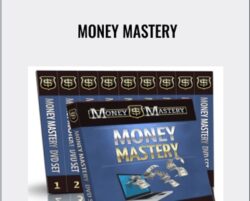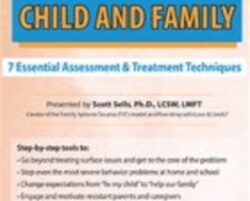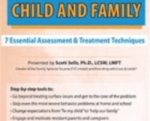Young clients are often referred to therapy because of an overt behavior problem – acting out, shutting down, skipping school, self-harm, aggression, running away – not the underlying trauma and unhealthy family dynamics that are the real cause of the problem. And while you can make some progress individually, lasting change is unlikely when the child returns to the same unhealthy dynamic at home.Trauma affects the entire family – shouldn’t treatment do the same?Watch Dr. Scott Sells, founder of the Family System Trauma (FST) Model and creator of Parenting with Love and Limits®, to learn 7 must-have, evidence-based techniques for assessing and treating the traumatized child in a whole new way.Under Dr. Sells’ expert guidance, you’ll discover how you can:Engage and motivate even the most resistant parents and familiesKeep session work focused, strategic, and solution-orientedEmpower caregivers to improve boundaries, attachment, discipline and communicationOvercome the most common treatment roadblocks that frustrate you and your clientUtilize easy to follow handouts and resources to help facilitate changeIf you’re treating young people, you need these techniques in your clinical toolbox!Differentiate between event-based and interactional trauma as it relates to assessment and treatment planning with the family.Utilize therapeutic tools, scripts, and handouts to conduct family therapy with traumatized children more effectively.Identify “undercurrents”, or hidden causes of trauma, that are contributing to symptomology within the family to increase the effectiveness of treatment.Create clinical treatment plans that are designed to address the specific needs of each client/family.Utilize various scaling techniques to evaluate progress in treatment and identify potential risks for relapse.Ascertain when it is appropriate to begin active treatment as opposed to stabilization of symptoms to ensure the safety of the child and family members.7 Essential Assessment & Treatment Techniques#1 – Psychoeducation: Trauma, Behavior, and How the FST Model Can HelpWhy the Family System Trauma (FST) Model worksThe long-term impact of out of control behavior and an upside-down hierarchyWhat is event-based v. interactional trauma?Setting expectations for treatmentVideo case example: ”The police officer who apologies to his family”#2 – Undercurrents: Help Families Identify the Core Drivers of Unhealed TraumaRecognize unhealthy interactional patterns that cause or maintain the traumaRoot work vs. Weed work: Where you will spend your session time?How to inject healthy undercurrents into the familyVideo case example: An out of control mother: villain, victim or hero?#3 – The 15 Minute Motivational Phone Call: Engage the Family Before Treatment Begins7 questions to quickly motivate and build rapportThe importance of understanding before persuadingAvoid the call becoming a therapy session: the “stick and move” techniqueClosing arguments – the most important piece of the callVideo case example: “Just fix my kid”#4 – The Stress Chart and Seed/Tree Diagram: Assess and Diagnose Quickly and AccuratelyUsing scaling from 0% (no stress) to 100% (total stress) to quickly get to the problemIdentify four toxic “seeds” that maintain the child’s problem behavior or symptomsAssess for the child’s safety stressors (self-harm, suicide, bullying, aggression)Identification of seeds and symptoms by child, family and FST therapistWhen to stabilize and when to start active trauma treatmentVideo case example: ”Knowing where to tap” to locate the core trauma drivers#5 – The Ethnographic Interview: Using Client Feedback to Improve Outcomes5 key questions for the end of each session (and why)Why real-time client feedback will improve outcomesHow to elicit honest responses from clients and familiesDeliver vs. content: It’s not what you say but how you say itVideo case example: ”We finally feel a part of the treatment”#6 – Trauma Playbooks: Step-by-Step Strategies that Convert Treatment Concepts to ActionHow to create a customized trauma playbook that:Activates the client and family to execute their part of the planHeals the stronghold of shame, blame, performance and approvalUses the child’s love language and is easily understood by everyoneHow to adjust playbooks as treatment progressesTroubleshooting, dress rehearsals, and next stepsVideo case example: The self-harming teen overcomes the stronghold of shame#7 – Evaluate Progress and Relapse PreventionMini-scales technique: Reveal progress made on problematic undercurrentsMap out next steps of treatment and beyondIdentify red flags to prevent potential relapseVideo case example: See the mini-scales and decision tree techniques in actionLimitations of the Research and Potential RisksGet Treating the Traumatized Child and Family: 7 Essential Assessment and Treatment Techniques of author Scott Sells only price 87$Tag: Treating the Traumatized Child and Family: 7 Essential Assessment and Treatment Techniques – Scott Sells Review. Treating the Traumatized Child and Family: 7 Essential Assessment and Treatment Techniques – Scott Sells download. Treating the Traumatized Child and Family: 7 Essential Assessment and Treatment Techniques – Scott Sells discount.
 Money Mastery – Mike Litman & Steve G. Jones
₹5,478.00
Money Mastery – Mike Litman & Steve G. Jones
₹5,478.00
 Conversational Marketing – David Cancel & Dave Gerhardt
Conversational Marketing – David Cancel & Dave Gerhardt
Treating the Traumatized Child and Family: 7 Essential Assessment and Treatment Techniques – Scott Sells
₹13,778.00




